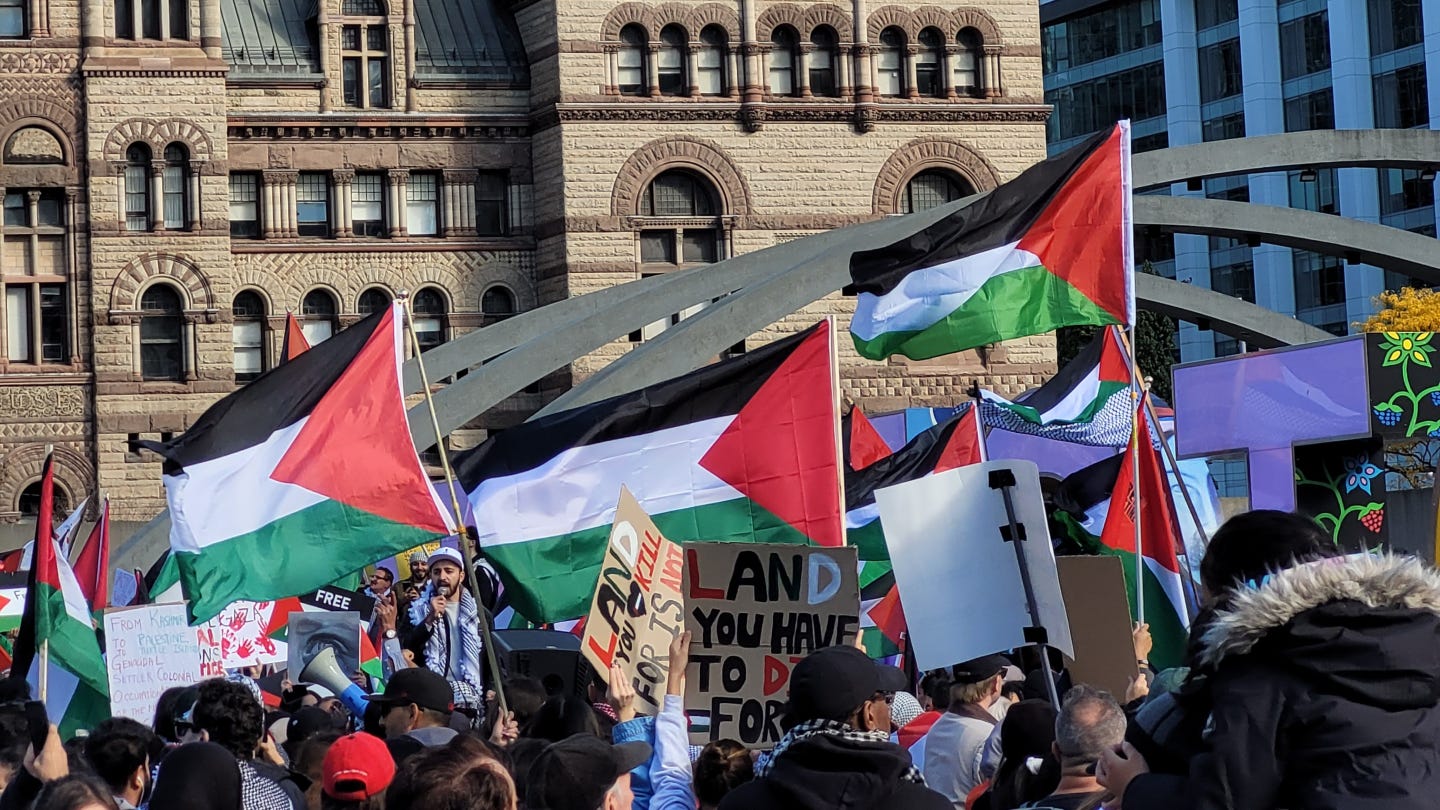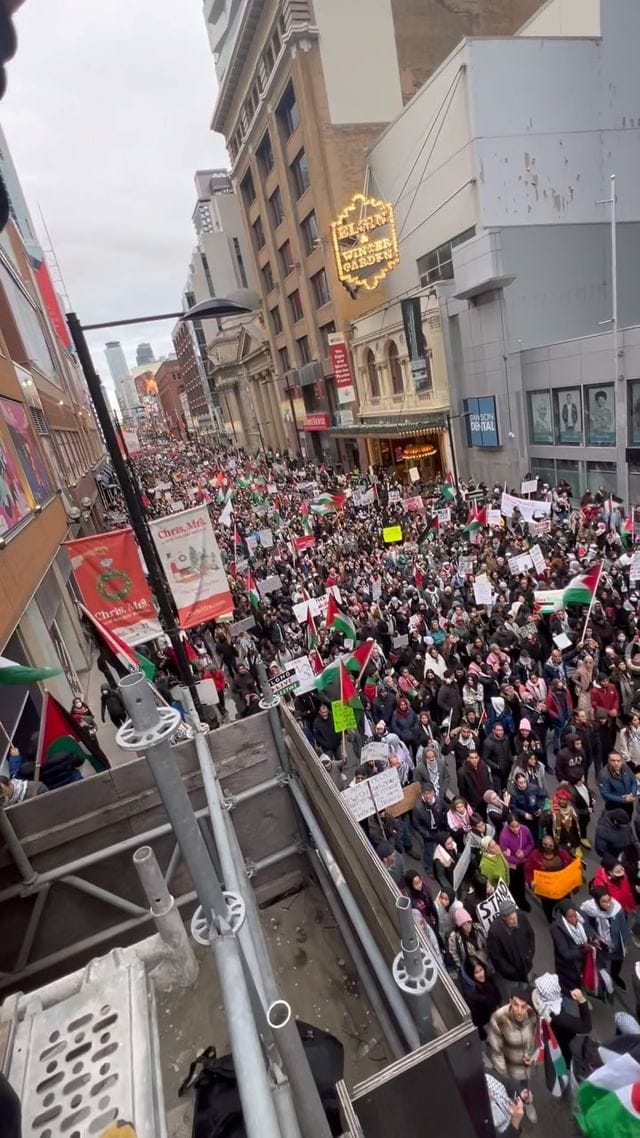When Reality Fails, Change It
The view from the ground doesn't line up with the news agencies reporting it

On Friday, October 27, after Israel cut communications to Gaza, an emergency rally was called in support of the Palestinian cause in Toronto. The social media posts asked people to show their support at 8pm in front of the Israeli consulate at 2 Bloor Street East. Though the rally was only called within three hours, enough people were present to shut down the intersection, spilling out past the traffic lights. Signs like “Trudeau stands with genocide,” “Condemn the siege,” and “Free Palestine” were strewn throughout the crowd. The speaker thanked everyone for coming out, asking them to do the same thing the next day.
On the 28th, in Nathan Phillips Square, the crowd was noticeably larger. Palestinian children began by reading stories from other children trapped in Gaza to the massive crowd. Once the protest took to the street, it completely filled four city blocks, at least. The crowd was so large that at least three sections of the march were chanting something different, all with similar volume. The Palestine flags, protest signs and kuffiyehs overflowed, squeezed between supportive allies on all sides. They all called for an end to genocide.
Sunday was another massive showing for the people in Palestine under attack by constant Israeli bombardment. Yonge Street was filled with people as far as the eye could see, all calling for a cease fire.
Where was the news? As of writing, here’s where coverage is at.
CBC News has no coverage of the event on their website, with the last article mentioning the Israel-Palestine situation in the Toronto context bemoaning the lack of free speech on campuses. The article gives passing mention to rallies, with the only photo from one an extreme close-up that gives no sense of scale.
City News had one segment on the rally from Saturday, with the text of the article writing that “It called for an ‘immediate, durable and sustained humanitarian truce’ in the region, but did not mention Hamas, its attacks or its tactics [Emphasis added].” The article also points out the people killed or taken hostage by Hamas, directly, but phrases the Palestinians killed by Israel like this:
The Palestinian death toll in Gaza on Saturday rose to just over 7,700 people in the three weeks since the war began, with 377 deaths reported since late Friday, according to the Gaza Health Ministry. A majority of those killed have been women and minors, the ministry said.
Killed by whom?
City also mentioned the rallies more broadly in the closing paragraphs of a piece on a vigil that was held for the victims of the Hamas attack. CP24 put the most stressing facts front and centre for their headline, “Roads closed, traffic delayed as thousands attended pro-Palestinian rally in downtown Toronto.” For their piece on Sunday’s demonstrations it mentioned “This was third consecutive weekend of significant demonstrations in Toronto related to the Israel-Hamas war.”
The piece felt the need to dedicate a significant amount of its article on a “Humanitarian Aid Heist in Gaza,” before finishing with a warning from Toronto Police about hate crimes. Tucked between these two digressions is a begrudging acknowledgement, “Reports from the Associated Press indicate the death toll among Palestinians has passed 8,000, including ‘mostly women and minors.’”
Global News reported on the Sunday rally, equating it with the vigil at the Holocaust Memorial, previously mentioned in the City news piece. While it’s important to report on this vigil, the crowd shown in City footage is nowhere close to the numbers at the pro-Palestine rallies that took place over multiple days this weekend.
This isn’t the only example. On October 31, a country-wide protest called for people to occupy the offices of 17 MPs who refused to call for a ceasefire. The Breach is the only outlet to dedicate significant space to the protests and their goals. That’s not to say there was no reporting by legacy outlets, CTV News ran a short, 260 word piece on the Edmonton protest. The Montreal Gazette did the same, in a very short piece.
Perhaps most egregious was the piece by Global News focusing primarily on the Guelph office of Liberal MP Lloyd Longfield. Explaining the protester’s actions, the article twists itself into pretzels to abdicate Israel of responsibility. It reads “protesters read out names of Palestinians that were killed by what they claim was the result of an attack by Israel in response to the one by the terrorist group Hamas on Oct. 7 [Emphasis added].”
There’s an easier way to write that sentence. But perhaps not an easier way to obscure the reality of Palestinians killed by Israel.
Microcosm
It’s telling that Global was the most dedicated to equating the pro-Israel and pro-Palestine camps for the Sunday rallies, as well as pretzeling words to obscure Israel’s culpability. They had fired a Palestinian journalist for posting about the assault her people are under on social media.
“Being their only Palestinian journalist in the newsroom, I thought my voice would matter the most to them during these times, but maybe I was mistaken.”
Zahraa Al-Akhrass, a former video journalist for Global News, was told to take down every post or comment with three hashtags that drew attention to the Palestine genocide. She said she got “not a single word of sympathy from anyone on an organizational level,” but was instead disciplined for sharing images of the Palestinian genocide. She tried to communicate her reality with another colleague and attached a photo of a child who had been killed by Israel in a reply to an email. Al-Akhrass had hoped to explain what this has done to her, emotionally. This employee then chewed out Al-Akhrass for sending such a disturbing photo.
Mondoweiss, an independent news outlet that covers Israel/Palestine and the US relationship to it, published an article titled “We are witnessing the largest U.S. anti-war protests in 20 years.” The article goes through the massive numbers showing up in cities across the US to demand an end to the Palestine genocide. This includes Friday’s demonstration which saw thousands of protesters, organized by Jewish Voice for Peace, shut down Grand Central Station in New York City, which saw hundreds of arrests.
But it also includes the massive default of news media to either not cover these rallies at all, or to downplay their effects.
Al-Akhrass is an example of this playing out with real consequences in the Canadian context. It’s incredibly doubtful that Global would fire an Israeli employee for posting about the Hamas attacks. Their faux-dedication to “balance” led them to fire a Palestinian employee for raising awareness of the genocide her people are facing. Much like their news coverage, their balance only works one way.
The War on Journalism
Alongside this biased reporting, Israel has continued its threats and attacks on journalists. Reporters Without Borders (RSF) said that the Reuters reporter who was killed in a strike on Lebanon was targeted, alongside six other injured journalists. Even though RSF did not directly attribute it to Israel, they found the attacks were intentional.
It is unlikely that the journalists were mistaken for combatants, especially as they were not hiding: in order to have a clear field of vision, they had been in the open for more than an hour, on the top of a hill. They were wearing helmets and bullet-proof waistcoats marked ‘press’. Their car was also identified as ‘press’ thanks to a marking on the roof, according to witnesses.
Israeli airstrikes killed the wife, daughter and son of Al Jazeera Gaza Bureau Chief Wael Dahdouh. On Oct. 30, Al Jazeera Gaza reporter Youmna ElSayed was threatened by the Israeli Military to leave her home with her family, despite being under bombardment and all available passages being targeted.
Since Israel denied bombing the al-Ahli Hospital last week, they have since given an evacuation order to the al-Quds Hospital, where 12,000 civilians are huddling for safety. Israel has also been bombarding around the area.
Taken in concert with the attacks on Al Jazeera as an institution and the brutalization of reporters by Israeli forces mentioned last week, the utility of journalism is undeniable. Still, our news media takes a bias towards Israel. This dynamic requires constant attention.
Reporting Live From the Abyss
On Tuesday, Oct. 17, an explosive hit the al-Ahli Arab Hospital in Gaza, killing over 400 people. In the immediate following of the attack, an IDF spokesman said they had no knowledge of the strike. Approximately an hour la…
But it’s important to note in this conversation that there have been noticeable spikes in hate committed under the guise of this conflict. Earlier this week, Russians in Dagestan stormed an airport in search of Jewish passengers from Israel, looking to harm them.
According to the Toronto Police, a source that should always merit scrutiny, hate crimes in the city have increased. Though police statements should not be taken at face-value, it’s not unreasonable to assume that antisemites would take any chance to exert their hateful beliefs. The same applies to Islamaphobes. But that means that care should be taken to cut through any statement that could apply to antisemitic tropes.
The news media is biased towards Israel, and against Palestinians. This is unequivocally due to shared geopolitical interests of the ruling capitalist class. Israeli organizations that push back against certain media coverage of the area is a factor, to be clear, but these organizations also fall within that dynamic.
It is in the ideological interests of news agencies in countries that align with Israel to cover them favourably.
It’s the same reason that coverage is biased against Cuba or China. It’s news from a pro-capitalist, pro-settler-colonial lens. Conversely, the coverage of systems they align with may be critical towards certain aspects, but not of the system overall.
When the coverage of these massive protests is downplayed, contorted, or ignored, it’s clear what the news media is doing. It isn’t reporting what’s happening on the ground. At best, news shapes these protests into the best possible version that aligns with institutional framing. After all, reality is what you make of it.




